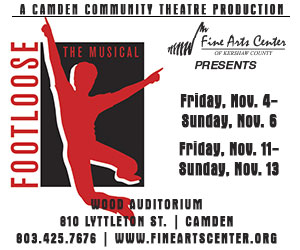Grande Dames of the Ballet Boards – 10 Questions with the Ladies Lumpkin and Harris
By Cynthia Boiter
The adage that behind every great man is a great woman has never been truer than when peering over the shoulders of the artistic directors of Columbia’s two top ballet companies, William Starrett of Columbia City Ballet and Radenko Pavlovich of Columbia Classical Ballet. Respectively, Coralee Harris and Lee Lumpkin have served for years as the backbones of the ballet companies they love, support, sponsor, and fight for. Sometimes against one another.
In the world of arts organizations, the boards of directors play parts that, though not on the stage, in many ways equal those of the artists and administrations involved. Jasper pulls back the ballet curtains to query steadfast ballet board members Lumpkin and Harris on how they arrived at their authoritative positions, how they handle the gentlemen at the helms of their organizations, and what they think of the other dance company.
What is the first ballet performance you remember seeing?
Harris:
Of course I have early memories of Nutcracker, Sleeping Beauty, and Coppelia, but the most vivid memory of my youth is seeing Dame Margot Fonteyn and Rudolph Nureyev perform together – the pas de deux from Swan Lake. It was 1971 or 1972 and they were touring in Miami. I cried. She retired in 1979.
Lumpkin:
My father was a great adventurer and we were in Russia in the early 70s. I had the great privilege of my first ballet being the Bolshoi. I can’t remember anything except its utter magnificence. I was so greatly impacted by the knowledge of its vast government support and so affected by seeing all socio-economic groups in attendance.
How long have you been involved in your ballet company and in what capacities?
Harris:
I moved to Columbia in 1990 and began going to an occasional [Columbia City Ballet] performance. I think it was in the mid-90s that I actually bought a membership (and still am a member). I would see Marvin Chernoff in the lobby and he would say, “You should be on the board.” In 2000, I was asked to join the board as President and ended up serving two terms in that capacity. I’ve been on the board ever since; sat on the Executive Committee for a number of years, and am currently completing a second term as Vice President.
Lumpkin:
I joined the board of Columbia Classical Ballet on December 27, 1996. I was clueless as to what lay ahead! I came on board to chair the second LifeChance auction and became the board chair in April. My primary job was to help with the transition from a civic company into a professional company. That was why I was brought on. Some of the board members wanted to stay civic so it was not an easy transition but, without question, [it was] what was meant to be. Within a few months I became the government grant writer (not without a few mishaps) and to this day it remains my very favorite part of what I do.
What inspired you to become involved in your ballet company?
Harris:
I came from Miami. My experience with ballet had been in Miami, New York City, Washington, DC, and Boston. The company I worked for in Miami was a big supporter of ballet and the CEO served on the Miami Ballet board. I saw the importance of committed board members to the success of an arts organization.
Lumpkin:
I was completely inspired by my daughter, Leigh Morgan, who was a beautiful dancer. She says it brings her great joy that I found my passion through her.
What is the best thing about working with your ballet company’s artistic director?
Harris:
William Starrett’s energy is contagious and his vision is grand. He is always working and creating and striving to improve the Company. On a personal note, William can always make me laugh. He has a genuine warmth about him that many people don’t see.
Lumpkin:
It’s the amazing personal relationship that’s created when you believe in the same things, like Radenko Pavlovich and I do – the great friendship that evolved. I have known for some time that he is a genius in his field and to be surrounded by that is indescribable.
What is the greatest challenge about working with him?
Harris:
You know the saying that sometimes our greatest strength is also our greatest weakness? Because William has such a grand vision and commitment, he often becomes frustrated; and that frustration has a trickledown effect. That’s when a reality check is in order.
Lumpkin:
The greatest challenge is created by Radenko’s genius – the demand for perfection. He is a visionary so he always wants more and better. All he sees is the art – that’s it. For it not to be superb and accessible to all is not an option. Thus it is the job of the board to make that happen. What’s so hard about it is that we know whatever he puts on that stage will be his best, so he is deserving of our best. Consequently, the demand for our excellence to support his is a constant challenge – but worth it.
What is the most important asset of a successful board of directors?
Harris:
All not for profit boards need a good mix of donors, doers and door-openers. An effective board must have a mix of talents and acknowledge the role each person plays; it is hard work to keep that balance in place.
Lumpkin:
I believe that the greatest asset of a successful board of directors is to be there for each other and a common goal.
What one thing can make a board of directors ineffective?
Harris:
Sometimes the boards, particularly in an arts organization, get caught up in the art and forget that they are there to do administer to the business. Without recognizing the duties and responsibilities of board membership, it’s easy to slip into the blue sky perspective. One of my personal business mantras is “all unhappiness is due to unrealized expectations.” The board needs to set realistic expectations, the art should motivate them, but their focus should be on the P&L (profit and loss).
Lumpkin:
If you are not on the same page as a board member and there is inner conflict, it can absolutely de-energize everything positive. There has got to be good positive energy for good positive outcome. It’s not enough to be with someone – you must be for them to make it work as a whole.
Years ago, there was a great deal of discussion about the possibility of Columbia City Ballet and Columbia Classical Ballet merging into one glorious ballet company. What do you think the state of ballet in Columbia would be today had this happened?
Harris:
I’m going to answer this as a business woman having been involved in bank mergers for many years (and these are my opinions and not that of the Board or CCB); there is the business of the ballet and the art of the ballet. In the business environment the art translates to the culture of the organization.
From the business perspective, a merger would have brought some efficiencies of scale on the expense side, perhaps allowing for more dancers, a longer season. A combined company may have improved ticket sales but it wouldn’t have doubled since both companies have cross over audiences. Public and private funding wouldn’t have doubled either, but would have been proportionately combined. While there may have been some financial benefits, it would not have been significant if you consider what happened to the economy since those talks began and the overall state of arts funding in this country.
As for the culture or art of the ballet, I believe it would have been a difficult evolution for the combined company. As in a business merger, you have to have one CEO for the new group; embracing one culture. And over time a single, hopefully combined theme and vision emerges. William and Radenko brought different cultures to the table. Both are very talented and passionate about their art and vision for dance in this community. We would have lost one of them and that would not have produced a “glorious ballet company”, but would have left us with the perception of a surviving ballet company. There will always be comparisons.
Columbia boasts a number of dance companies, not just Columbia City and Columbia Classical and I rarely hear about any move to merge any of the other groups. Competition is good; it keeps us all on our toes.
Lumpkin:
Interestingly enough, I think the state of ballet would have been just as the question implied – glorious. It would have taken extraordinary patience, discipline, skill, etc., but I will always believe that it could have been grand. But again, everyone has to be on the same page and timing is almost everything! And as life would have it, the state of ballet in Columbia in 2012 is none the less – glorious. City Ballet has just celebrated 50 years and Classical Ballet has just celebrated 20 years. They are both proud companies who found, created, and sustained their niches.
Throughout the years, you’ve seen many excellent dancers come and go – who was, or is, your favorite and why?
Harris:
In my first year as president, I went to the studio to introduce myself to the dancers. I told them then, and believe it now, that each one of them are someone’s favorite dancer. At each performance someone in the audience is looking for them on stage and watching their every movement. I have been amazed by the talent that has performed as part of the Company. When I invite people from out of town to a performance, they are amazed that we have this level of talent in Columbia, South Carolina.
There is one dancer that I have been able to watch grow over the last twelve years, personally and professionally. Her lines are exquisite, her technique is reaching perfection, and her stage presence can be mesmerizing: that would be Regina Willoughby – my adopted dancer daughter.
Lumpkin:
My favorite international ballet dancer is Misha Ronnikov. He was from the Bolshoi and quite superb. He asked me to help him get his green card and I began a journey with him I would wish on no one, but one I would never have missed. When it was over and he had his freedom, I thought he would stay with our company. But he wanted something else for himself. It was at that moment when you realize you don’t help someone fight for their freedom and then be mad that they don’t choose what you wanted. That’s why we are the greatest country on earth and it’s no wonder everyone wants to be here. I was greatly humbled by the experience and feel like a made a difference in his life as he made in mine.
What do you admire most about Columbia Classical Ballet?
Harris:
Fortitude.
Lumpkin:
Without question I most admire the tenacity of William Starrett and, in turn, the tenacity of City Ballet.






.jpg)
